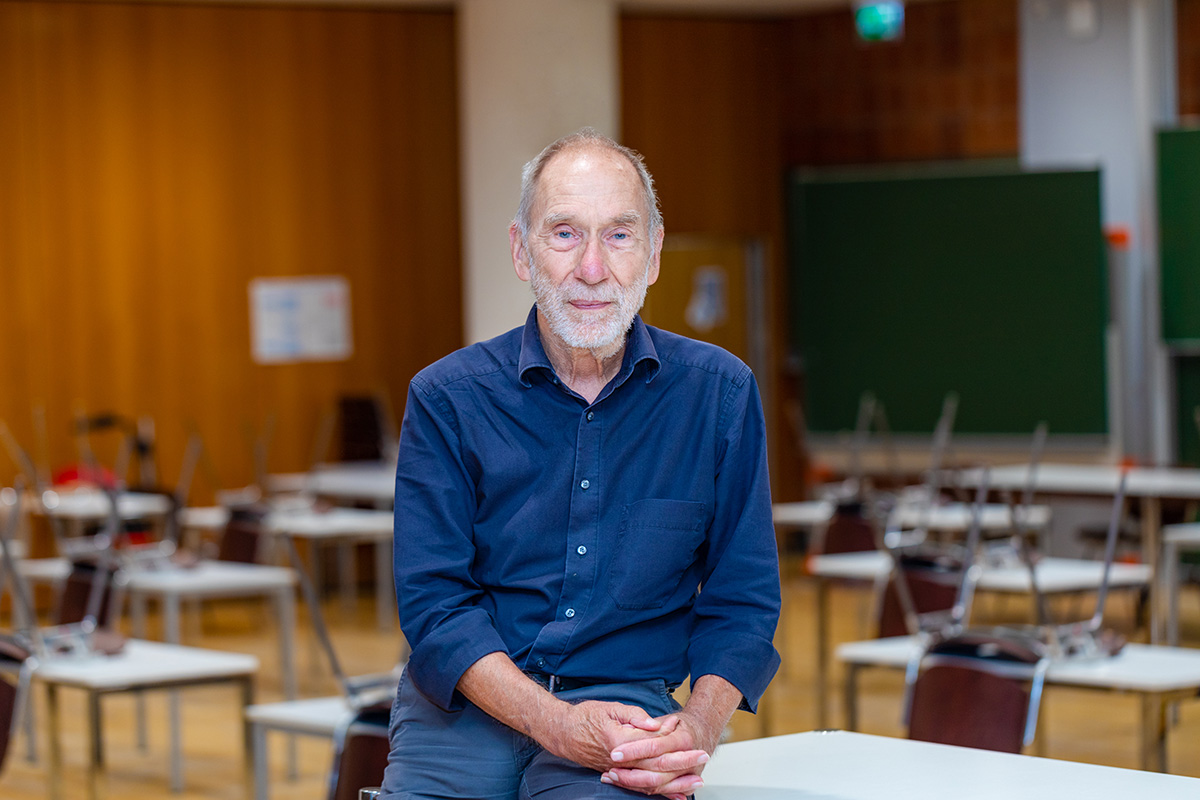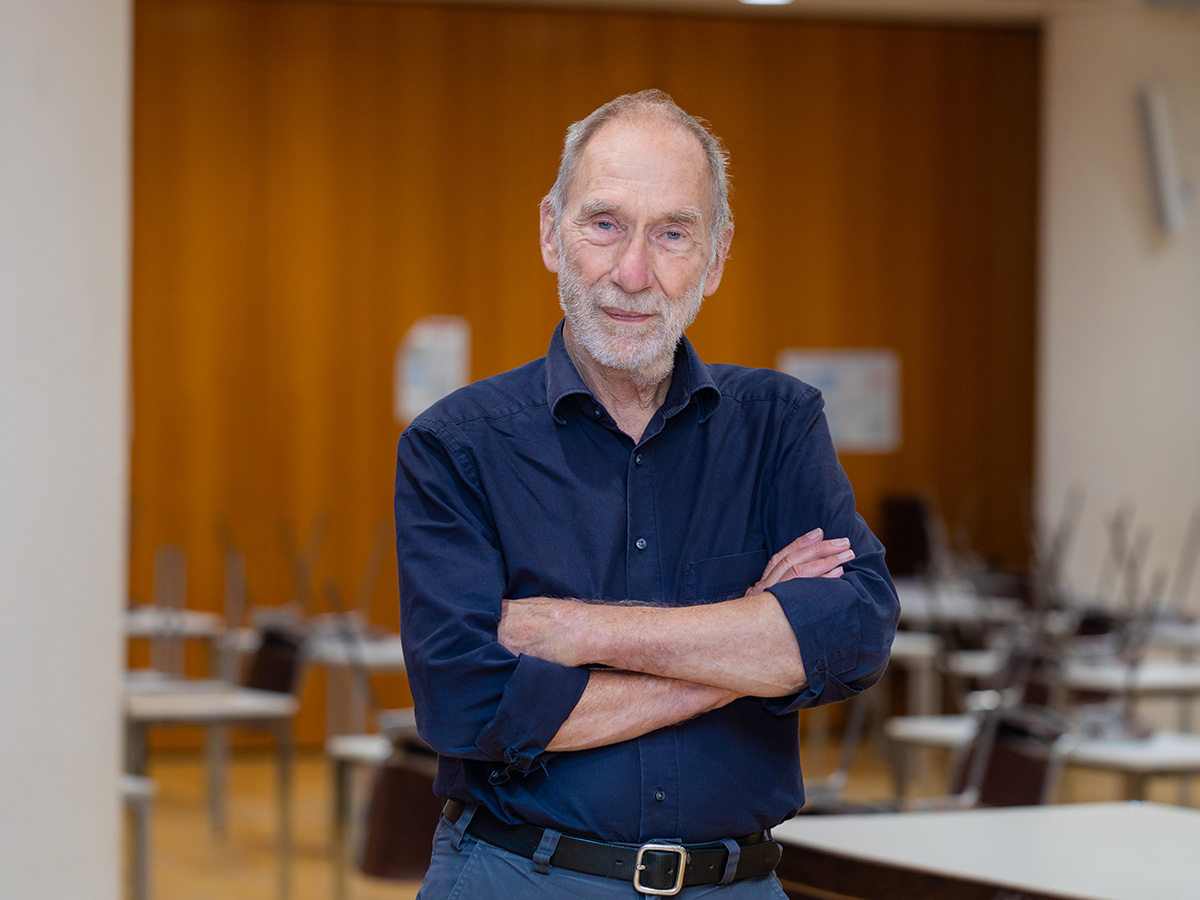
© Matej Meža / Universität Bremen
His Last Lecture
The longest-serving professor at the University of Bremen, Frieder Nake, says goodbye
On January 30, 2024, Professor Frieder Nake goes into well-deserved retirement. Well-deserved is not just a saying at this point, but a fact: the current semester was his 103rd at the University of Bremen. In autumn 2021, the up2date editorial team met with the computer science professor who has been at the University of Bremen almost as long as the university has existed. At the time, Nake was close to his 100th semester – his 103rd has now come to an end. The 85-year-old computer science professor was then and is now certainly worthy of a campus story. Because he experienced the beginning years of the reform university in Bremen first-hand? Of course. But mainly because he’s fantastic at telling stories.
His narrations are particularly well suited to a specific location on campus: the lecture hall of MZH building. This is where Nake has spent so many hours of his professional life. Conveniently, the lecture hall is directly opposite his office and apparently, there’s no need for him to even put on shoes. He simply crosses the hall in his comfy mules. Right? “No, these are my normal shoes. I basically wear sandals all year round, as long as it is possible,” corrects Nake. A black shirt, hiking trousers with practical side pockets, and thick wool socks round off the look – the tanned professor needs nothing more for a day at the university.
“My teaching style was always quite relaxed,” smirks the computer scientist, who accepted a professorship in graphic data processing and interactive systems at the University of Bremen in 1972. Searching for specialist literature or PowerPoint slides with equations in his classes is pointless. “I prefer to talk to my students. In that way, I pass on the specialist knowledge in a casual way and always in reference to a relevant issue,” explains Nake.
Sitting in a Circle with Students
With this approach, he has aligned his teaching with one of the founding ideas of the University of Bremen. A great deal was meant to change on the Weser River at the beginning of the 1970s. One aspect of said change was that research and teaching were supposed to be relevant to society. For Nake, this means that he sat together with five students in a circle during his first seminar, and in the frame of so-called project studies, he spoke with them about the opportunities and limits posed by computers using the example of job placement. A civil servant from the Federal Labor Office in Nuremberg even came to the University of Bremen to find out more about the ideas of the students and their professor. “Everything that happened at the university back then had a direct connection to reality. I liked that,” says the computer scientist. What he also enjoyed was the so-called one-third parity at the University of Bremen in the 1970s. Professors, administrative staff, and students held the same rights in all matters. “The one-third parity was sensational. I had never experienced anything like it in Germany,” enthuses Nake.

© Matej Meža / Universität Bremen
Professorship as Political Task
That so much was intended to be different at the University of Bremen was the reason that the native of Stuttgart returned to Germany from Canada at all in 1972. “I had emigrated several years previously because I found the German higher education system to be too rigid,” says the scientist. “Becoming a professor at this radically different university was a political task for me,” explains Nake.
In what way? “Since the age of 16, I always felt like I belong to the radical left,” clarifies Nake. He was a member of communist associations and even had to go through disciplinary proceedings in the 70s in the frame of what is known as the Anti-Radical Decree. He stands by his political beliefs, despite the fact that a great deal has now changed at the University of Bremen. Marxism and a continual call for dialectical thinking influence his teaching. “We should always remember to think about the opposite. This is what I taught my children and I recommend it to each of my students. There is not one person who took part in any of my classes who does not know the name Hegel.”
Teaching as Storytelling
Nake laughs when asked if he is sure that he teaches computer science. “Viewing the bigger picture is part of the job. Teaching must be storytelling and should position itself based on specialist knowledge,” he states.
A while ago, he taught a seminar entitled “Algorithmic Thinking.” Seventy students took part and he knew weeks in advance how he would begin the course: by going in, sitting down, and saying nothing. For a whole ten minutes. If someone whispered or moved in their chair – he ignored it. After ten minutes, he stood up and asked: What did you think just then? “That is how students find out what it means to be reduced to our thinking,” explains the university lecturer. The university as a happening. That’s how he likes it best.
90-Hour Weeks Are Normal
And when he’s not at the university? “Work is my life. I work a 90-hour week and finish in the evening just as the “heute journal” TV show is starting,” he says. He does, however, give himself one moment of peace each day: The computer scientist loves eating a slice of bread with cheese in the small kitchen of his Borgfeld house and looking out to the big trees in the garden.
What many people at the university do not know is that Frieder Nake is a famous computer artist. He creates art digitally using a computer. In the middle of the 1960s, he was one of only three artists worldwide who worked on this type of art and he became internationally known in an extremely short space of time. “I create projections on large displays that continually change without repetition. The computer calculates, works, and then shows the art. They are dynamic images that appear when we look,” explains Nake.
He will definitely continue to create computer art. But his time teaching at the university comes to an end on 30 January. Unless he changes his mind again – which would not be out of character. At least that is what other colleagues in his faculty think. His (for now?) last lecture “Move On! - A Perspective of Digital Media” starts as usual at 2 p.m., but this time in the Kunsthalle. After 13 weeks of intensive engagement with algorithmic art, its most important representatives and the context in which their works can be seen, this lecture at the Kunsthalle promises to be the crowning conclusion for this course. In the gallery of prints (Kupferstichkabinett), the approximately 30 master’s students and their lecturer will look at and discuss various works of computer art, which are usually in storage. A suitable farewell event for a computer scientist and artist who has enriched the lives and learning of countless students at the University of Bremen for 103 semesters.
More Information
Article in the WESER KURIER newspaper (only in German)